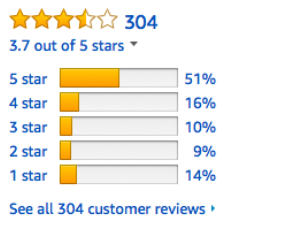Whether you’re selling on Amazon, your own web-shop, or a profitable combination of omni-channel marketplaces, good inventory management is crucial to success.
Every e-commerce seller knows that good inventory management isn’t easy, but it does ensure that you have products to sell when you need them. And, while anyone can see that stock outs or overbuying inventory contribute to problems in warehousing and in inventory costs, they also contribute to issues with marketing and direct customer relationships.
That’s crucial, especially when you’re spending big on Facebook, Amazon or Google ads to drive customers to your products. If your inventory management software is hurting sales, or worse, preventing them, you’re literally throwing money away.
While inventory problems are numerous, some stock and pipeline issues directly impact your marketing results. Recognizing where issues are happening and stepping in to optimize and take control will improve your bottom line.
Inventory Availability Affects Demand
Economics 101 says that when supply is lower in one area it rises in another. This holds true in a world of digital economic demand. You can assume that anyone who would potentially purchase a product from you is equally willing to purchase one from your competitor. And, if you’re on Amazon, you don’t have one competitor, you have dozens or even thousands. So, if your products are running low or even out of stock, your marketing ads are directly promoting competitor products.
For example, Amazon, Facebook and other platforms don’t tie ads to product availability. Instead, they will continue to run the ad, even when your product is about to sell out or already sold out. The ineligibility of the product is your responsibility because their platform isn’t sophisticated enough to track and shut down your ad for you. Instead, most shopping platforms will suggest another, in-stock product once they click through to your sold-out product and if you’re selling on Amazon this means it could show your competitor’s product.
Worst case scenario, your ad budget is directly promoting your competitor’s products each time you sell out.
What can you do about it? Integrate automated reordering tools to ensure that stock out events don’t happen. Tools like Skubana track inventory according to average rate of sale and send alerts when you reach a point where you have to reorder to prevent selling out. Of course, you will have to manually adjust if you’re planning to run promotions and sales which could result in a very fast sell-out of existing inventory.
Amazon Suppresses Sold-out Listings
It may be old news, but it’s important to consider. Amazon and other e-commerce platforms are actively trying to make money. If your products are sold out, they have no reason to show your listing at the top of search or anywhere else. Stock out events and low stock actively hurt your organic ranking and therefore Amazon SEO – which will dramatically reduce sales. Why? Amazon actively hides sold-out products from any customer who hasn’t actively chosen to see out of stock items in their search.
Chances are that a large portion of your Amazon marketing efforts go into boosting organic ranking, and stock-outs undo all of your hard work. What happens once you’ve sold out? You can restore most of your pre-stock out ranking by using a promotion or coupons to make a large number of sales to alert Amazon that your product is back in action.
However, the best medicine is still prevention. If you can manage your inventory and your FBA inventory to prevent selling out completely, your listing ranking will be better off for it.
Negative Feedback Harms Conversion
 It’s undoubtedly true that inventory problems affect the customer experience. Whether receiving slow orders, the wrong product, or damaged products because of rushed or improper shipping, poor inventory management negatively affects the customer experience. These customers then go on to leave negative reviews, tell their peers about their experience, and even post on their own channels. This will negatively hurt your branding and reduce the efficacy of your marketing by lowering conversion.
It’s undoubtedly true that inventory problems affect the customer experience. Whether receiving slow orders, the wrong product, or damaged products because of rushed or improper shipping, poor inventory management negatively affects the customer experience. These customers then go on to leave negative reviews, tell their peers about their experience, and even post on their own channels. This will negatively hurt your branding and reduce the efficacy of your marketing by lowering conversion.
For example, if reviewers complain about a 10 day wait for a product, you’ll lose anyone who needs the product sooner, even if you’ve since fixed the distribution issue. Similarly, if a customer demands their money back or opens a case against you through Amazon or eBay, it could directly and negatively impact your entire account reputation and standing.
Poor Supply Chain Management Increases Product Cost
Whether you have too much inventory or not enough, it will increase costs. Switching to efficient inventory management solutions like Just in Time (JIT) or similar will give you more flexibility to reduce costs, by cutting the total storage costs for products in FBA or your warehouse. However, you have to balance storage costs with pipeline costs such as shipping, loading and unloading, and processing products into your warehouse. Once you find that balance, you’ll save considerably over having large amounts of inventory piling up and possibly remaining in your warehouse, paying too-frequent shipping and processing fees, or selling out.
While there’s no one-size-fits-all solution to inventory management, there are plenty of solutions you can look at and test in your own warehouse to reduce costs.
Large Inventory Contributes to Slow Shipping Times

If you’re selling on Amazon but not storing inventory with them, then chances are it is slowing you down. Slow shipping times contribute to lowered customer satisfaction, reduced ranking on Amazon, and, if slow enough, actual negative health on your account.
What can you do about it? Whether you sell on Shopify, Amazon, eBay or all of the above, review your inventory and cut slow moving stock, figure out an inventory schedule that works for your sales rate and forecasted sales, and work to slim down inventory so you never have more than you can easily catalogue and sort through for optimized shipping.
Inventory Doesn’t Restructure to Meet Demand
Most inventory management options are inefficient at quickly adapting to meet new needs. However, if you’re running marketing promotions, sales, or specific deals and discounts, you have to be able to adjust your inventory to keep up. This is important if you want a sale to run through and benefit ranking and reviews on products and then shift back to meet normal sales velocity. The “problem” here is that a standard order point (such as set period or based on static sales velocity) doesn’t update based on minute changes, and you will sell out if velocity increases or will overstock if it begins to drop.
Good inventory management benefits every aspect of your e-commerce business, and it will improve marketing results. With inventory tying into promoted products, customer satisfaction, inventory availability, and organic ranking on Amazon, there’s a lot to gain by optimizing backend processes. And, with most inventory optimization tying into overhead costs, you will save money as well.
While there’s no best solution, your ideal inventory management options depend on warehouse size, product type and lifecycle, and even pipeline sourcing. You should experiment with your ERP to automate processes and improve efficiency to find out what works best for your business.